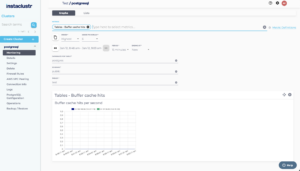Table Metrics
The Tables metric group contains metrics providing information about the usage and performance of tables in your PostgreSQL cluster. The metrics available are:
- Tables – Row metrics
- Tables – Blocks hit & read
- Tables – Index & sequential scans
- Tables – Dead Rows
- Tables – Buffer cache hits
- Tables – Disk blocks read
- Tables – Table & index size
Row metrics

Rows inserted
The Rows inserted metric provides the number of rows inserted in a PostgreSQL table each second.
Rows updated
The Rows updated metric provides the number of rows updated in the PostgreSQL table each second.
Rows deleted
The Rows deleted metric provides the number of rows deleted in the PostgreSQL table each second.
Blocks hit & read

Blocks hit
The Blocks hit metric provides the number of block hits per second resulting from queries on a table. Block hits occur when PostgreSQL is able to avoid reading a block from the disk because it is already cached in memory.
Blocks read
The Blocks read metric provides the number of disk blocks read per second as a result of queries on a specific PostgreSQL table.
Index & sequential scans

Index scans
The Index scans metric provides the number of index scans of the table initiated per second. Index scans occur when queries result in the PostgreSQL Planner deciding to use one or more indexes to determine which rows are relevant to the query, instead of reading the whole table.
Sequential scans
The Sequential scans metric provides the number of sequential scans of the table initiated per second. Sequential scans occur when queries result in the PostgreSQL Planner deciding to scan the entire table, reading it from disk sequentially. When dealing with large tables, sequential scans can be very expensive in terms of both IO and processing resources.
Dead rows

The Dead rows metric provides the number of dead rows in a table. When a row of a table is updated or deleted, it is not actually removed from the disk and it persists as a ‘dead row’ until the VACUUM operation is called (usually by PostgreSQL’s autovacuum daemon). This frees the space to be reused.
Buffer cache hits

The Buffer cache hits metric provides the number of buffer cache hits per second as a result of queries against all indexes on a table. A buffer cache hit occurs when PostgreSQL is able to avoid reading a block from the disk because it is already cached in memory.
Disk blocks read

The Disk blocks read metric provides the number of disk blocks read per second as a result of queries against all indexes on a given table.
Table & index size

Table size
The Table size metric provides the total disk space taken up by a given table, excluding its indexes.
Index size
The Index size metric provides the disk space taken up by all indexes of a given PostgreSQL table.